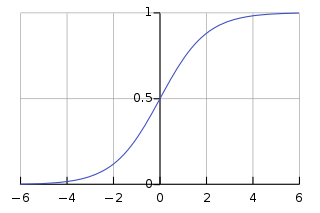
A Malthusian catastrophe is a prediction that population growth will outpace agricultural production – that there will be too many people and not enough food.

In mathematics, two varying quantities are said to be in a relation of proportionality, if they are multiplicatively connected to a constant, that is, when either their ratio or their product yields a constant. The value of this constant is called the coefficient of proportionality or proportionality constant.

A logistic function or logistic curve is a common "S" shape, with equation:

Exponential growth is exhibited when the rate of change—the change per instant or unit of time—of the value of a mathematical function of time is proportional to the function's current value, resulting in its value at any time being an exponential function of time, i.e., a function in which the time value is the exponent.
Exponential decay occurs in the same way when the growth rate is negative. In the case of a discrete domain of definition with equal intervals, it is also called geometric growth or geometric decay, the function values forming a geometric progression. In either exponential growth or exponential decay, the ratio of the rate of change of the quantity to its current size remains constant over time.
In population ecology and economics, maximum sustainable yield or MSY is theoretically, the largest yield that can be taken from a species' stock over an indefinite period. Fundamental to the notion of sustainable harvest, the concept of MSY aims to maintain the population size at the point of maximum growth rate by harvesting the individuals that would normally be added to the population, allowing the population to continue to be productive indefinitely. Under the assumption of logistic growth, resource limitation does not constrain individuals' reproductive rates when populations are small, but because there are few individuals, the overall yield is small. At intermediate population densities, also represented by half the carrying capacity, individuals are able to breed to their maximum rate. At this point, called the maximum sustainable yield, there is a surplus of individuals that can be harvested because growth of the population is at its maximum point due to the large number of reproducing individuals. Above this point, density dependent factors increasingly limit breeding until the population reaches carrying capacity. At this point, there are no surplus individuals to be harvested and yield drops to zero. The maximum sustainable yield is usually higher than the optimum sustainable yield and maximum economic yield.

Zero interest-rate policy (ZIRP) is a macroeconomic concept describing conditions with a very low nominal interest rate, such as those in contemporary Japan and December 2008 through December 2015 in the United States. ZIRP is considered to be an unconventional monetary policy instrument and can be associated with slow economic growth, deflation, and deleverage.
The Lotka–Volterra equations, also known as the predator–prey equations, are a pair of first-order nonlinear differential equations, frequently used to describe the dynamics of biological systems in which two species interact, one as a predator and the other as prey. The populations change through time according to the pair of equations:

Population dynamics is the branch of life sciences that studies the size and age composition of populations as dynamical systems, and the biological and environmental processes driving them. Example scenarios are ageing populations, population growth, or population decline.
A population decline in humans is any great reduction in a human population caused by events such as long-term demographic trends, as in sub-replacement fertility, urban decay, white flight or rural flight, or due to violence, disease, or other catastrophes.. Contrary to contemporary belief, depopulation can be largely beneficial for a region, allocating more resources and less competition for the new population, in addition to exempting the disadvantages of overpopulation, such as increased traffic, pollution, real estate prices, and environmental destruction. Per-capita wealth may increase in depopulation scenarios, in addition to improvement of environmental quality-of-life indicators such as improved air and water quality, reforestation, return of native species, etc. The accompanying benefits of depopulation have been termed Shrink and Prosper, with benefits being similar to the Post Civil War Gilded Age, Post World War 1 Economic Boom and the Post World War 2 Economic Boom.
In biology or human geography, population growth is the increase in the number of individuals in a population.
Many of the world's countries, including many in Sub-Saharan Africa, the Middle East, South Asia and South East Asia, have seen a sharp rise in population since the end of the Cold War. The fear is that high population numbers are putting further strain on natural resources, food supplies, fuel supplies, employment, housing, etc. in some of the less fortunate countries. For example, the population of Chad has ultimately grown from 6,279,921 in 1993 to 10,329,208 in 2009, further straining its resources. Vietnam, Mexico, Nigeria, Egypt, Ethiopia, and the DRC are witnessing a similar growth in population.
Zero growth may refer to:

Intraspecific competition is an interaction in population ecology, whereby members of the same species compete for limited resources. This leads to a reduction in fitness for both individuals.
By contrast, interspecific competition occurs when members of different species compete for a shared resource. Members of the same species have very similar resources requirements whereas different species have a smaller contested resource overlap, resulting in intraspecific competition generally being a stronger force than interspecific competition.
Population Matters, formerly known as the Optimum Population Trust, is a UK-based charity that addresses population size and its effects on environmental sustainability. It considers population growth as a major contributor to environmental degradation, resource depletion, conflict and involuntary migration and societal problems such as housing scarcity and transport congestion.
Precycling is the practice of reducing waste by attempting to avoid bringing items which will generate waste into home or business. The U.S. Environmental Protection Agency (EPA) also cites that precycling is the preferred method of integrated solid waste management because it cuts waste at its source and therefore trash is eliminated before it is created. According to the EPA, precycling is also characterized as a decision-making process on the behalf of the consumer because it involves making informed judgments regarding a product’s waste implications. The implications that are taken into consideration by the consumer include: whether a product is reusable, durable, or repairable; made from renewable or non-renewable resources; over-packaged; and whether or not the container is reusable.

In demographics, the world population is the total number of humans currently living, and was estimated to have reached 7.6 billion people as of May 2018. It took over 200,000 years of human history for the world's population to reach 1 billion; and only 200 years more to reach 7 billion.

Zero Population Growth: Bliss Out Volume 15 is a 1999 album by Lilys. Part of the Darla Records Bliss Out series, it represents a departure by Lilys leader Kurt Heasley into what has been called "krautrock-ish electronica". The album was recorded in collaboration with producer Trevor Kampmann of hollAnd, and was released in May 1999 in the UK and July 1999 in the US.









